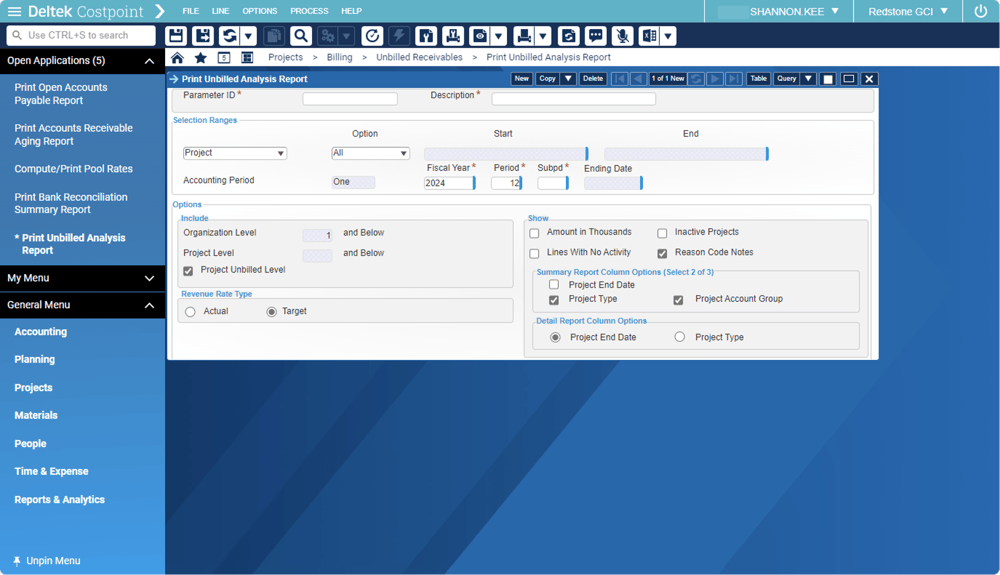
As we get closer to the fiscal year-end for government and calendar year filers, now is the time to start thinking about cleaning up your subledgers!
In this article, we will explain what a subledger is, explain why it is a problem if they are out of alignment, explain how this happens, and then give you some ideas on what you can do to fix it.

What is a Subledger?
A subsidiary ledger (subledger) is a subset of the general ledger that contains more transaction details than the general ledger. Relating to Accounts Payable, for example, the general ledger of your AP account will show some of the basics of the transaction: amount, vendor, and posting date (whether a voucher or a disbursement). However, you would not be able to easily see which transactions have not been paid, when those transactions are due, the vendor’s terms, and many other details. These details are held only in the Accounts Payable subledger. There are similar subledgers throughout Costpoint, for example: Accounts Receivable, Unbilled, Allocations, Cash, and more.
Why Subledgers That Tie are Integral to Accounting System Compliance
A difference between the general ledger and the applicable subledger indicates a problem. Costpoint was designed to have internal controls baked into each subledger, but journal entries can bypass those controls. Auditors know this, so they will likely ask you for a listing of journal entries during their auditing procedures. They will review the entries to locate misstatements or internal control issues. Additionally, the subledgers are used to substantiate the general ledger data, so if they do not tie, they will first ask you to explain any differences, generally on a very tight timeline.
How Do the Subledgers Get Out of Balance?
Mistakes in journal entries are the biggest culprits behind these ledgers getting out of balance – especially journal entries to the following system-controlled accounts: Accounts Payable, Accounts Receivable, Fixed Assets, Accumulated Depreciation, Unbilled Receivables, Revenue, and Salaries & Wages Payable. There could be times when journal entries are appropriate, but it is rarely the best course of action. The best method is to go back to the original method of entry and make corrections through that method to ensure the impact on the correct accounts and the subledger. Less often, there is an error in setup screens that can cause an issue; for example, the accounts payable account gets incorrectly assigned to a new deduction code or used in a cash receipt transaction. These are rare cases, but the errors would not be identified without reviewing and reconciling your subledger.
When Should You Review and Reconcile the Subledgers?
Easy - every month! By reconciling the subledger monthly, any issues are identified quickly. In the case of a journal entry, this allows the correction to occur within the same period as the initial error. In the case of the incorrect setup, it prevents the problem from growing and involving multiple transactions. Additionally, correcting the issues in the current fiscal year is far easier than once they cross over to another fiscal year. Identify the subledgers which are applicable to your company and make reviewing them a standard part of your monthly closing process.
Some Special Mentions
- Statement of Indirect Expenses (also referred to as pools or allocations) - Many often forget this item, but it is also a type of subledger, and an important one. Pools should be posted each month and tied back to the general ledger on a regular basis to ensure all costs are being allocated. The most significant issues are usually in pool setups, with accounts or organizations missing or duplicated. Again, by identifying the problem early, the errors are not perpetuated into the subsequent periods.
- Unbilled - In our previous articles, we have covered unbilled receivables in some depth (Understanding Deltek Costpoint Unbilled Receivables and Costpoint - Managing Your Unbilled Receivables Doesn’t Require Magic). Still, it is worth mentioning again that problems between your unbilled subledger and general ledger could point to issues in billings to your customers and in revenue recognition and profitability. Ensure the project ledger and general ledger match on the unbilled report, and ensure any balances shown within the unbilled account are explainable.
Potential Fixes
The fix will, of course, depend on the type of issue between the subledger and general ledger. But some potential fixes to keep in mind are:
- First, identify what caused the issue. Identify how the issue started before making a journal entry (or another journal entry) to correct a problem. Was it a transaction or journal entry posted to a system-controlled account? Was it an amount coming from a setup (e.g., a deduction code, advance codes)?
- When a journal entry was the culprit - return to the source. Reverse the reclassifying journal entry, and re-enter using the correct subledger transaction (voucher, timesheet, invoice, revenue journal)
- If it was due to a new setup, ensure the setup or code is updated as part of the correction.
- Separate accruals into another General Ledger account rather than using system-linked accounts.
- Where possible, utilize two sets of eyes on transactions, especially with journal entries. Before posting, review the entry for accounts that cause issues.
- The two sets of eyes can also apply to a new setup. When adding new codes, have a second person review the setup before use.
We covered the concept of subledgers, explored common issues that can arise, and explained why they matter. We also discussed the importance of regularly reviewing subledgers and offered some potential solutions for resolving issues when they occur. If you need help identifying and resolving these issues, the Redstone GCI team is here to assist. We will be sharing articles with tips on preparing for year-end processes, and we're always just a phone call or email away. Whether you're looking for proactive support or facing an urgent problem, we're here to help.


 Senior Managing Consultant
Shannon is a Senior Managing Consultant in Redstone GCI’s Costpoint Consulting Team. She has used Deltek Costpoint with government contractors for over 10 years. Her experience has covered multiple areas within the system and involved more than the standard day-to-day transactions. She led teams through several system modifications and upgrades, including reorganizations, merging databases and system enhancements.
Shannon is extremely organized and deadline-focused and brought these strengths to her team by utilizing technology to streamline workflows, develop job documentation and use the system to ensure the organization worked smarter, not harder.
She enjoys writing custom reports for her clients and has published many reports that have helped end-users retrieve the data they need in the format they require. Providing automated reports that save them time, improve accuracy and alleviate the need to juggle multiple spreadsheets manually.
Professional Experience
Shannon started her career supporting a large manufacturing company, working in corporate accounting on mark to market accounting for hedge and derivative activities, preparing filings and intercompany eliminations. She then transitioned to an operating group responsible for centralizing all accounting functions for all plants. She was selected for the process improvement team to streamline all templates and close processing.
After obtaining her CPA license, she spent several years working in public accounting preparing individual and trust tax returns. She then entered the world of Deltek Costpoint, working at a not-for-profit. She was responsible for all general ledger and intercompany activities for four entities and creating standardized processes for these areas.
Then, she transitioned to the for-profit world, becoming the director of finance and accounting. She successfully led all financial, DCAA, NASA, and ERISA audits and was instrumental in obtaining a certified accounting system and preparing the annual incurred cost submissions. She also served as the SAAS admin, leading multiple successful Costpoint upgrades and reorganizations. She also functioned as the main report writer for the company – turning ad hoc data requests into repeatable reports that stakeholders could run ad hoc, or have delivered to their inboxes.
Senior Managing Consultant
Shannon is a Senior Managing Consultant in Redstone GCI’s Costpoint Consulting Team. She has used Deltek Costpoint with government contractors for over 10 years. Her experience has covered multiple areas within the system and involved more than the standard day-to-day transactions. She led teams through several system modifications and upgrades, including reorganizations, merging databases and system enhancements.
Shannon is extremely organized and deadline-focused and brought these strengths to her team by utilizing technology to streamline workflows, develop job documentation and use the system to ensure the organization worked smarter, not harder.
She enjoys writing custom reports for her clients and has published many reports that have helped end-users retrieve the data they need in the format they require. Providing automated reports that save them time, improve accuracy and alleviate the need to juggle multiple spreadsheets manually.
Professional Experience
Shannon started her career supporting a large manufacturing company, working in corporate accounting on mark to market accounting for hedge and derivative activities, preparing filings and intercompany eliminations. She then transitioned to an operating group responsible for centralizing all accounting functions for all plants. She was selected for the process improvement team to streamline all templates and close processing.
After obtaining her CPA license, she spent several years working in public accounting preparing individual and trust tax returns. She then entered the world of Deltek Costpoint, working at a not-for-profit. She was responsible for all general ledger and intercompany activities for four entities and creating standardized processes for these areas.
Then, she transitioned to the for-profit world, becoming the director of finance and accounting. She successfully led all financial, DCAA, NASA, and ERISA audits and was instrumental in obtaining a certified accounting system and preparing the annual incurred cost submissions. She also served as the SAAS admin, leading multiple successful Costpoint upgrades and reorganizations. She also functioned as the main report writer for the company – turning ad hoc data requests into repeatable reports that stakeholders could run ad hoc, or have delivered to their inboxes.